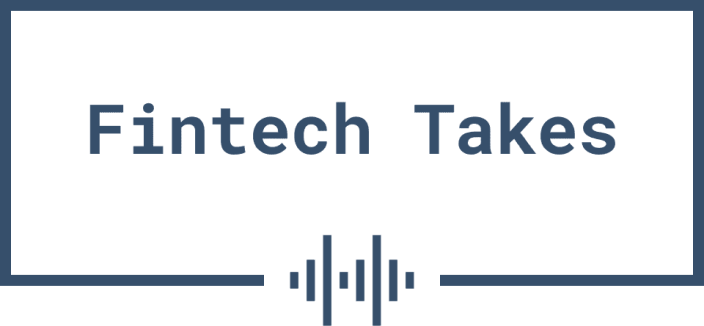
3 FINTECH NEWS STORIES
#1: Apple Pay Plays Nice
What happened?
The next version of Apple Pay, coming this fall, will mark a very significant pivot for Apple’s financial services strategy:
Apple Pay introduces even more flexibility and choice for users when they check out online and in-app. Users can view and redeem rewards, and access installment loan offerings from eligible credit or debit cards, when making a purchase online or in-app with iPhone and iPad. These features will be available for any Apple Pay-enabled bank or issuer to integrate in supported markets.
The ability to access installments from credit and debit cards with Apple Pay will roll out starting in … the U.S. with Citi, Synchrony, and issuers with Fiserv. Users in the U.S. will also be able to apply for loans directly through Affirm when they check out with Apple Pay.
So what?
The Affirm news is the one that got all the attention in the business press, and understandably so. If you’re curious about the direction of Affirm’s stock price, then finding out that Apple will be presenting Affirm installment loans is a big deal!
However, I think the more interesting part of the story is Apple’s decision to allow any third-party card issuer to offer their own BNPL installment loan directly within the Apple Pay checkout flow.
As Tom Noyes reported on his blog, this capability is being enabled directly by Apple, through integrations with specific issuers (Citi, Synchrony) and processors (Fiserv), rather than through the network’s BNPL schemes. That’s FASCINATING. The card networks have done a lot of work to try to keep that volume on their rails. Mastercard introduced its own absurdly expensive BNPL scheme (Mastercard Installments) a few years ago (which all merchants promptly opted out of supporting). And Visa’s recent announcement of Flexible Credential seemed designed to facilitate this exact use case (flexible financing at the point of sale) on an issuer level.
With this announcement, Apple is saying that it wants flexible financing at the point of sale to happen at a wallet level rather than at a network or issuer level, which strikes me as a very smart and aggressive move.
It’s also an acknowledgment that consumer lending is really freaking hard. In conjunction with this announcement, Apple also confirmed today that it will be winding down its own BNPL offering, Apple Pay Later:
Starting later this year, users across the globe will be able to access installment loans offered through credit and debit cards, as well as lenders, when checking out with Apple Pay. With the introduction of this new global installment loan offering, we will no longer offer Apple Pay Later in the U.S.
Our focus continues to be on providing our users with access to easy, secure and private payment options with Apple Pay, and this solution will enable us to bring flexible payments to more users, in more places across the globe, in collaboration with Apple Pay enabled banks and lenders.
As I have written and podcasted about numerous times over the last year, Apple’s original BNPL strategy, which involved lending off of its own balance sheet using its own state lending and collections licenses, was crazy. However much additional margin it was picking up by building Apple Pay Later internally, it was nothing compared to the additional reputational, legal, and credit risk it was taking on.
Picking up pennies in front of a steam roller can seem like a good idea when your boss is yelling at you about services revenue, but it’s never a sustainable way to grow.
#2: I’m Finally Figuring Figure Out
What happened?
After expressing my long-held confusion about Figure in the newsletter a few months ago, I was (through the help of my wonderful subscribers) able to have a few conversations with Figure’s Co-Founder, Mike Cagney. Those chats were very illuminating, and well-timed because Figure just made a big announcement:
Figure Technology Solutions … today announced the launch of Figure Connect, a first-of-its-kind blockchain-based multi-seller, multi-buyer marketplace of private credit loans.
Figure Connect brings Figure’s broad and deep capital markets buyer universe directly to Figure’s loan origination partners. With Figure Connect, originators can receive forward commitments from buyers, lock active bids, control loan pricing to balance profitability and volume, and deliver pools of loans into those commitments. This functionality is facilitated with common, standardized sale terms and documentation.
So what?
If that doesn’t make any sense to you, don’t worry. I was in the same boat until very recently.
Allow me to provide a simplified explanation:
- The core premise of Figure is that blockchain technology can be used to dramatically streamline the lending process, resulting in significant efficiency and cost improvements. However, in 2018 (when Figure was founded), no one who worked in lending believed that, so Figure had to demonstrate it by using its proprietary blockchain-based lending platform to originate and sell loans itself. The company decided to pick Home Equity Line of Credit because HELOCs were complex and time-consuming to manufacture, and there wasn’t much competition.
- After originating a portfolio of HELOCs using its lending platform, Figure then had to figure out how to sell its loans to secondary market investors (beyond the warehouse facility that it initially secured in 2018). This wasn’t easy because Figure’s approach (enabled by blockchain) was specifically designed to cut third-party review (TPR) firms – the companies that review loans for secondary market investors – out of the process (thus cutting a lot of cost out of the system). Figure did its first securitization deal in 2020, and last year it did its first AAA-rated securitization.
- Having demonstrated that investors were willing to buy loans originated through its fully automated platform, Figure set about recruiting third-party HELOC originators to manufacture more loans on the platform. Today, the company has more than 90 third-party lending partners, and it and its partners have originated over $10 billion in HELOCs.
- And that brings us to Figure Connect. The right way to think about Figure Connect is as a private market equivalent to Fannie Mae and Freddie Mac for non-QM mortgage lending products. Much like Fannie and Freddie with qualified mortgages, Figure has created a standardized manufacturing process for HELOCs by requiring all lenders to use its loan origination system (Fannie and Freddie have their own LOSs that they require mortgage originators to use). With Figure Connect, Figure is bringing standardization to the back end of the process, replacing private credit firms’ bespoke loan purchase agreements (LPAs) with a common multi-buyer, multi-seller LPA (similar to the standard agreements that Fannie and Freddie require). The first loan sale made using this common LPA was just made, marking the beginning of Figure Connect.
Put simply, Figure Connect is the endgame for Figure (Figure Markets, which just started, is a completely different ball of wax … don’t ask me about that one yet).
It remains to be seen if Figure will be able to replicate the same level of ‘always-on’ liquidity that Fannie and Freddie provide through their government-backed guarantees of cash flows on their pass-through securities (Figure is working to get a private guarantor for its marketplace). However, their progress to date has certainly been impressive.
#3: Wells Fargo Bilt a Bad Partnership
What happened?
The Wall Street Journal’s AnnaMaria Andriotis (who is a kick-ass reporter deserving of more recognition) broke a story about how the economics of fintech’s most confusing B2C product – the Bilt Card – actually works:
In 2022, Wells launched a credit card with Bilt Technologies, a fintech startup with big-name backers including Blackstone and Mastercard. The co-branded card came with a rare perk: Users can pay for rent with it without incurring fees from their landlords while also earning rewards points. More than one million accounts were activated in the first 18 months, many by young adults.
But Wells is losing as much as $10 million every month on the program as savvy customers flock to the card, according to current and former employees. Executives made internal projections on key revenue drivers, such as the likelihood that cardholders would carry balances, that turned out to be inaccurate.
So what?
Bilt has been confusing fintech observers for a while now. Back in February, after the company’s latest round of fundraising (which valued it at $3.1 billion), Jason Mikula and I tried to figure out how the company was able to make the economics on its card (which offers rewards to people who pay their rent with it) work.
Turns out that Wells Fargo, America’s favorite bank and the issuer of the Bilt Card, didn’t understand either. Here are some more details from AnnaMaria:
There is a reason why credit cards hadn’t gained traction in the rent sector until Bilt came along. Most landlords didn’t accept them because they refuse to pay card fees that get pocketed by the banks issuing them and often run between 2% and 3%.
Bilt structured the card so landlords won’t incur the fees. Wells instead eats much of that.
About six months after the credit card was launched, Wells began paying Bilt a fee of about 0.80% of each rent transaction, even though the bank isn’t collecting interchange fees from landlords.
Wells earns interchange fees every time people use the card to pay for anything but rent and splits those fees with Bilt.
Wells also pays Bilt $200 each time a new card account is issued. Such arrangements are often reserved for airline and other established credit-card programs.
The hope, from Wells Fargo’s perspective, was that cardholders would use the card for non-rent expenses *and* that many of them would revolve a balance month to month *and* that some of them would become Wells Fargo mortgage customers when they jumped from renting to homeownership.
None of that has happened at a rate anywhere close to what Wells Fargo projected, which has forced the bank to throttle back on marketing the card and to pressure Bilt into renegotiating the contract (which runs to 2029).
This is obviously very bad for Wells Fargo and is yet more evidence that even the biggest and most sophisticated banks can be lured into bad business deals when they chase shiny fintech objects (hi, Goldman Sachs!)
Here’s my thing, though – this is also really bad for Bilt.
I see this in fintech all the time. Very few startups understand what healthy business partnerships actually look like. Most of them view partnering the same way that they view procurement – as a contest to see who can extract the most concessions from the other party.
I can’t stress this point enough – THIS IS VERY BAD STRATEGY!
Fintech companies depend on their partners. Bank partners in particular. If you don’t have them, you don’t have a business. The goal in partnering with a bank should be to strike an equitable deal that has the potential to be mutually beneficial for both sides for a long time.
If your business model depends on your partners making dumb decisions, your business model is dumb.
2 FINTECH CONTENT RECOMMENDATIONS
#1: What are the tech solutions to Zelle fraud and scam resolution? (by Penny Crosman, American Banker) 📚
I really enjoyed Penny’s deep dive into the current state of fraud within the Zelle ecosystem and what the banks are trying to do about it.
My thing about Zelle has always been that the banks jumped way too far into the future (real-time payments, at scale, for free) without an adequate understanding of what they (and their customers) were getting into.
It’s been an educational experience, to say the least.
#2: What’s Holding Back Open Banking? (Matt Jones, Payments Culture) 📚
To paraphrase Mona Lisa Saperstein, HOW DID I NOT KNOW ABOUT THIS NEWSLETTER?!?
Sorry for yelling, but I get unreasonably mad whenever I discover a great fintech newsletter that somehow wasn’t already on my radar. And this one has been publishing awesome content for more than a year? Fuck!
Anyway, read this excellent article on what’s holding back open banking and pay-by-bank, and then subscribe to Payments Culture.
1 QUESTION TO PONDER
What questions do you have about BNPL?
My BNPL Summit is happening next week (tickets are still available!), and I’d love to know what questions you’d most like to know the answers to. Please send them to me!


